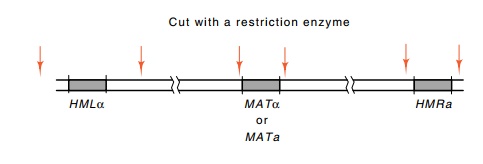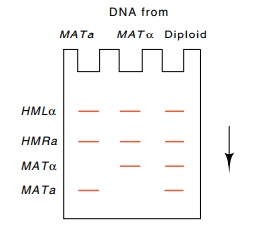Chapter: Genetics and Molecular Biology: Regulation of Mating Type in Yeast
Transfer of Mating Type Gene Copies to an Expression Site
Transfer of Mating Type Gene Copies to an
Expression Site
Once the MATα mating-type clone had been obtained by Hicks,
Strath-ern, and Klar, and by Nasmyth and Tatchell, Southern transfer
experiments testing DNA transposition to the MAT locus were possible. Yeast DNA was cut with various restriction
enzymes and was separated according to size by electrophoresis. The locations
of the α-specific or a-specific
sequences were determined by hybridization using the clonedα orasequences
as probe.
We might expect that the α mating-type locus would have no homology to the a mating-type locus. Then, in the DNA from a MATα cell there would be two
different DNA fragments with homology to the MATα locus, one from MATα itself, and one from HML or HMR. From a MATa cell we would expect only one fragment with homology to the α mating type sequence. Surprisingly, a different
answer emerged. The α se-quence also possesses partial
homology to a mating-type sequences.
Therefore three different sizes of restriction fragments were observed in the
DNA from MATa or MATα cells probed with either a or α sequences (Fig. 16.4). These are sequences at HML, HMR, and MAT.
Figure
16.4 Cleavage of DNA containing theHML, HMR,andMATloci by arestriction enzyme which does not cleave within the
loci..

The fact that the a-specific and α-specific sequences were partially homologous, but of different size permitted a direct and simple demon- stration of the basis of mating-type conversion.
The genetic data indi-cated that sequences from HML or HMR were copied
into MAT, where they were expressed.
Because the a mating-type sequence is
about 100 nucleotides shorter than the α mating type, the identity of the sequence occupying the MAT locus can be directly determined on
Southern transfers (Fig. 16.5). The experiments showed, as expected, that
mating type a cells possessed the a sequences at MAT, and that mating type α cells
possessed the α sequences at MAT. The Southern transfer of a diploid
yeast that possesses a MATa/MATα genotype yields two bands originating from the MAT locus that differ in size by 100
base pairs. The identity of the shorter and longer mating-type segments was
determined by isolating spores, growing, and testing both genetically as well
as performing a transfer. The a-type
cultures possess only the shorter MAT
sequence and the α-type cultures possess only the
longer MAT sequence.

Figure 16.5 Southern transfershowing that MATa sequences are about 100 base pairs shorter than MATαsequences.
Related Topics